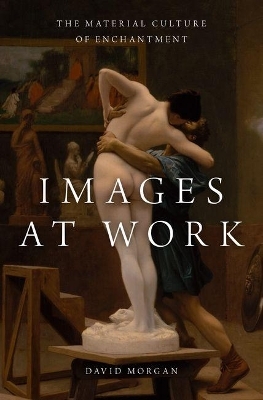
Images at Work
The Material Culture of Enchantment
Seiten
2018
Oxford University Press Inc (Verlag)
978-0-19-027211-1 (ISBN)
Oxford University Press Inc (Verlag)
978-0-19-027211-1 (ISBN)
Building on his previous innovative work in visual and religious studies, David Morgan creates a new framework for understanding how the human mind can be entranced, invigorated, and changed by images.
Images can be studied in many ways--as symbols, displays of artistic genius, adjuncts to texts, or naturally occurring phenomena like reflections and dreams. Each of these approaches is justified by the nature of the image in question as well as the way viewers engage with it. But images are often something more when they perform in ways that exhibit a capacity to act independent of human will. Images come alive--they move us to action, calm us, reveal the power of the divine, change the world around us. In these instances, we need an alternative model for exploring what is at work, one that recognizes the presence of images as objects that act on us.
Building on his previous innovative work in visual and religious studies, David Morgan creates a new framework for understanding how the human mind can be enchanted by images in Images at Work. In carefully crafted arguments, Morgan proposes that images are special kinds of objects, fashioned and recognized by human beings for their capacity to engage us. From there, he demonstrates that enchantment, as described, is not a violation of cosmic order, but a very natural way that the mind animates the world around it. His groundbreaking study outlines the deeply embodied process by which humans create culture by endowing places, things, and images with power and agency. These various agents--human and non-human, material, geographic, and spiritual--become nodes in the web of relationships, thus giving meaning to images and to human life. Marrying network theory with cutting-edge work in visual studies, and connecting the visual and bodily technologies employed by the ancient Greeks and Romans to secular icons like Che Guevara, Abraham Lincoln, and Mao, Images at Work will be transformative for those curious about why images seem to have a power of us in ways we can't always describe.
Images can be studied in many ways--as symbols, displays of artistic genius, adjuncts to texts, or naturally occurring phenomena like reflections and dreams. Each of these approaches is justified by the nature of the image in question as well as the way viewers engage with it. But images are often something more when they perform in ways that exhibit a capacity to act independent of human will. Images come alive--they move us to action, calm us, reveal the power of the divine, change the world around us. In these instances, we need an alternative model for exploring what is at work, one that recognizes the presence of images as objects that act on us.
Building on his previous innovative work in visual and religious studies, David Morgan creates a new framework for understanding how the human mind can be enchanted by images in Images at Work. In carefully crafted arguments, Morgan proposes that images are special kinds of objects, fashioned and recognized by human beings for their capacity to engage us. From there, he demonstrates that enchantment, as described, is not a violation of cosmic order, but a very natural way that the mind animates the world around it. His groundbreaking study outlines the deeply embodied process by which humans create culture by endowing places, things, and images with power and agency. These various agents--human and non-human, material, geographic, and spiritual--become nodes in the web of relationships, thus giving meaning to images and to human life. Marrying network theory with cutting-edge work in visual studies, and connecting the visual and bodily technologies employed by the ancient Greeks and Romans to secular icons like Che Guevara, Abraham Lincoln, and Mao, Images at Work will be transformative for those curious about why images seem to have a power of us in ways we can't always describe.
David Morgan is Professor of Religious Studies with a secondary appointment in the Department of Art, Art History, and Visual Studies at Duke University. He is the author of numerous books, including The Forge of Vision(2015), The Embodied Eye (2012), and The Sacred Gaze (2005).
Acknowledgements
Introduction
Chapter 1: To Believe & Make-Believe
Chapter 2: How Images Work
Chapter 3: Enchantment & Disenchantment
Chapter 4: The Ecology of Images
Chapter 5: Icon & Aura
Chapter 6: Chance & the Work of Enchantment
Conclusion
Notes
Select Bibliography
Index
| Erscheinungsdatum | 20.02.2018 |
|---|---|
| Zusatzinfo | 55 images with 20 in color |
| Verlagsort | New York |
| Sprache | englisch |
| Maße | 236 x 168 mm |
| Gewicht | 599 g |
| Themenwelt | Kunst / Musik / Theater ► Antiquitäten |
| Kunst / Musik / Theater ► Kunstgeschichte / Kunststile | |
| Sozialwissenschaften ► Ethnologie | |
| Sozialwissenschaften ► Soziologie | |
| ISBN-10 | 0-19-027211-2 / 0190272112 |
| ISBN-13 | 978-0-19-027211-1 / 9780190272111 |
| Zustand | Neuware |
| Haben Sie eine Frage zum Produkt? |
Mehr entdecken
aus dem Bereich
aus dem Bereich
von 1710 bis zur Gegenwart
Buch | Hardcover (2021)
Battenberg (Verlag)
29,90 €


